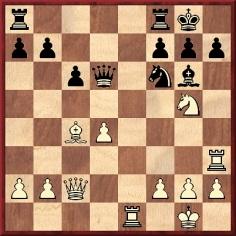
Edward Winter
(1995, with updates)
This position (White to move) comes from the 1942 correspondence game Wade v Bennett:

After 19 Qxg6 Black resigned in view of 19...hxg6 20 Bxf7+ Rxf7 21 Rh8+ Kxh8 22 Nxf7+ Kg8 23 Nxd6 Rd8 24 Re6.
This game (for which page 29 of Chernev’s Combinations The Heart of Chess incorrectly put ‘London, 1943’) gives rise to many complications.
Walter Korn provided the complete game on pages 162-163 of the July 1943 CHESS. The additions within brackets in the game-score are by us.
Robert G. Wade – E.W. Bennett
Correspondence game, New Zealand, 1942
Queen’s Gambit Declined
1 d4 d5 2 c4 e6 3 Nc3 Nf6 4 Bg5 Nbd7 5 e3 Be7 6 Nf3 O-O 7 Rc1 c6 8 Bd3 dxc4 9 Bxc4 Nd5 10 Bxe7 Qxe7 11 O-O Nxc3 12 Rxc3 e5 13 Qc2 exd4 14 exd4 Nf6 15 Re1 Qd6 16 Ng5 Bg4 (Levenfish v Riumin, Moscow, 1935 and Ståhlberg v Menchik, Łódź, 1938 both saw 16...Qf4 17 Nxf7. On page 71 of the Nottingham, 1936 tournament book Alekhine said that his game against ‘Petersen’ [Pettersson would be correct] at Örebro, 1935 had gone 16...h6 17 Nxf7 Rxf7 18 Qb3 and wins. In fact, the relevant Örebro game was against H. Carlsson, and White’s 18th move was Qg6. As Calle Erlandsson (Lund, Sweden) has pointed out to us, Alekhine annotated the game on pages 86-87 of the April 1935 issue of Tidskrift för Schack.)
17 Rg3
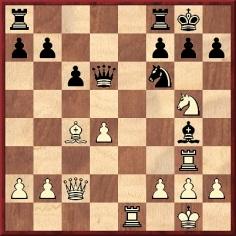
(Walter Korn now gave the variation 17...Qxd4 18 Nxh7 Nxh7 19 Re4. On page 189 of the September 1943 CHESS H.H. Cole said that this could be answered by 19...Bf5 ‘and I do not see any win for White; probably there is a better 18th move for him and I hope there is, because the real game was particularly brilliant.’ On page 191 of the September 1943 issue, C.H. Reid also gave this line and stated that White should therefore play 18 Re7, with the possible continuation 18...Bh5 19 Ne6 Qd6 (if 19...fxe6 then 20 Rgxg7+ Kh8 21 Rxh7+) 20 Nxg7 Bg6 21 Nf5 Qf4 22 Rxb7, with advantage. On page 12 of the October 1943 CHESS, J.J. O’Hanlon said that 18 Re7 could be answered by 18...Rad8. [18...Rad8 runs into trouble after 19 Rd3.] ‘It seems to me that the best line of play for Black is 17 Rg3 Bh5! 18 Rh3 h6 19 Rxh5 hxg5 20 Rxg5 Rfe8! with the better game.’ We wonder whether, in recommending 20...Rfe8, O’Hanlon took account of 21 Bxf7+.) [Regarding the suggestion by Cole, on 29 November 2008 Yasser Seirawan (Amsterdam) commented to us: ‘Besides 19...Bf5 there is also 19...Qd1+, exchanging queens. 18 Nxh7 is a mistake.’]
17...Bh5 18 Rh3 Bg6 (Korn: ‘18...h6 was necessary.’) 19 Qxg6 Black resigns.
Bob Wade (London) has informed us that, as stated on pages 27-28 of Neishtadt’s book on the Queen’s Gambit Declined (Moscow, 1967), the entire game was already known from analysis by Kopayev and Chistyakov dating back to 1938 (exact source not given by Neishtadt). Below is part of Neishtadt’s account, of which an English translation has kindly been supplied to us by Ken Neat (Durham, England):
‘How then should Black defend against the threat of 18 Rxg4?
The pawn capture 17...Qxd4 is strongly met by 18 Re7, while if 17...g6 18 h3. Black cannot reply 18...Bf5 in view of 19 Qxf5! gxf5 20 Ne4+ Qxg3 21 Nxf6+ Kg7 22 Nh5+ and 23 Nxg3, or 21...Kh8 22 fxg3. (This variation from the old analysis was also repeated in a game; 17 years later Kholmov lost in precisely this way to the German master Holtz at the tournament in Dresden, 1956.) And after 18...Bd7 19 Qb3 White maintains strong pressure (analysis by Kopayev and Chistyakov).
But perhaps the retreat of the bishop to h5 was not a mistake. Let us analyse other replies by Black, apart from 18...Bg6, which leads to a catastrophe.
Black can offer the exchange of rooks by 18...Rae8. After 19 Rxe8 Rxe8 20 Rxh5 (as will be seen later, 20 Nxh7 is better) 20...Re1+ 21 Bf1, and in the opinion of Gligorić White retains the advantage. 21...Nxh5 22 Qxh7+ Kf8 23 Qxh5.
But instead of 21...Nxh5 the “quiet” move 21...Qd5! gives Black the advantage. Therefore the old recommendation of Kopayev and Chistyakov should be considered: 19 Rc1, and if 19...Bg6 20 Qxg6, as in the variation examined earlier.
Thus Kopayev and Chistyakov convincingly showed that the immediate manoeuvre of the bishop to g6 is impracticable. And yet against the threat of 18 Rxg4 there is a defence. In the game Boleslavsky v Moiseev (Odessa, 1949) Black went in for this entire variation, which was considered unfavourable, and after 18 Rh3 he made the unexpected move 18...Qb4! By attacking the rook and saving the queen from the terrible fork with which the combination of Kopayev and Chistyakov concluded (Nxf7+), Black completes the bishop manoeuvre: 19 Rhe3 Bg6 20 Qb3 Qxb3 21 Bxb3 Rfe8. Black has avoided the dangers. After 22 Kf1 Kf8 the players agreed a draw.
It may be concluded that the seemingly formidable move 17 Rg3 is not so fearsome.’
Neishtadt also referred to Kopayev and Chistyakov’s 1938 analysis when giving the Qxg6 line on pages 129-130 of Queen Sacrifice (Oxford, 1991). [Walter Korn, for his part, returned to the Wade v Bennett game, mentioning the Kopayev and Chistyakov analysis, on page 106 of Chess Review, April 1967.] In both his above-mentioned books Neishtadt noted that the Qxg6 line subsequently occurred in the game Marović v Chagan (World Student Team Championship in Cracow, 1964). On page 96 of the Lachaga book on Moscow, 1935, Becker said that the 22 Nxf7+ 23 Nxd6 version was also played in Maccioni v Letelier in Santiago de Chile, 1945 and that the 1964 game brought White a brilliancy prize.
(2092)

Robert G. Wade (Chess World, March 1953, page 46)
On 28 July 1995 we received the following from Robert Wade:
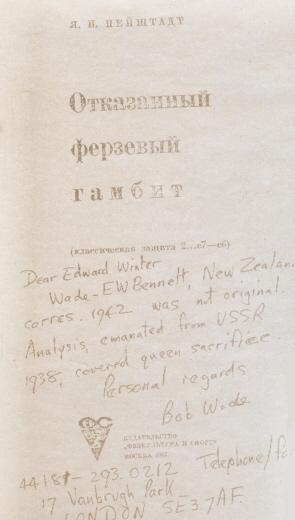
(7270)
Regarding the Wade v Bennett correspondence game (1942) and the prior appearance of 19 Qxg6 in analysis, below is an article on pages 183-184 of the September 1939 Chess Review:
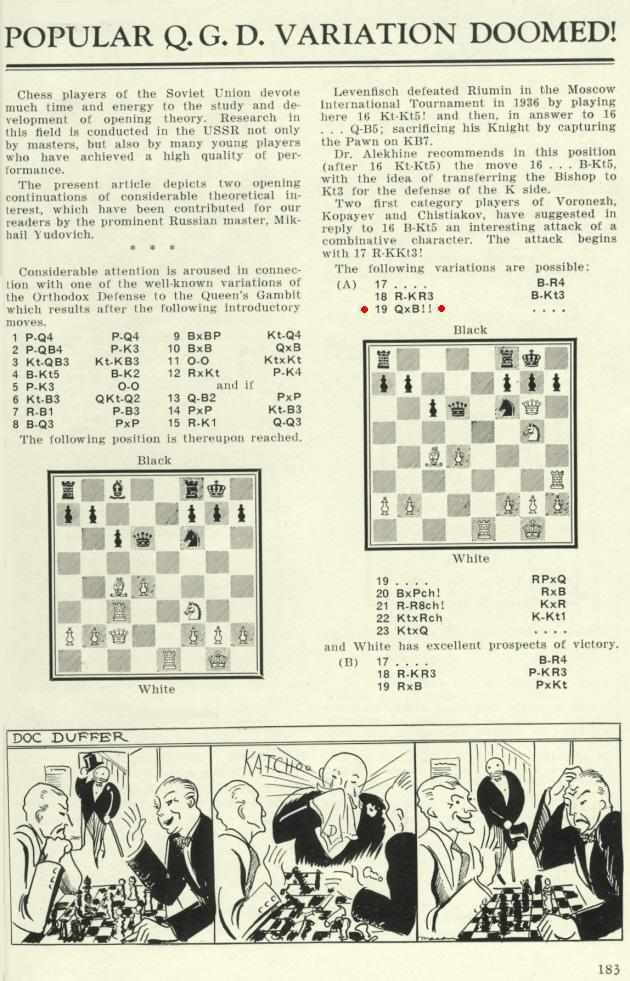
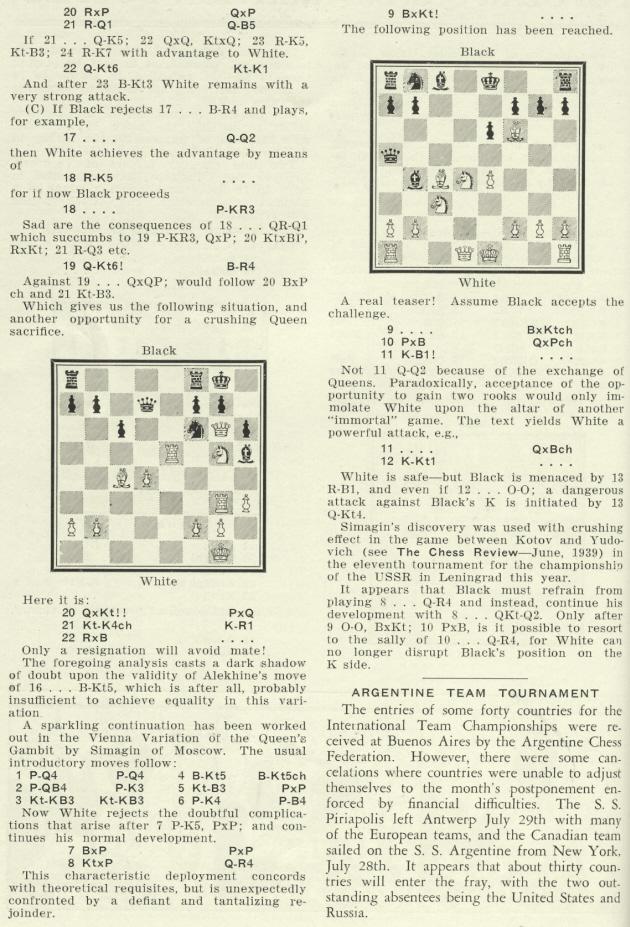
(7344)
Afterword: For further information on the Qxg6 sacrifice see pages 214-219 of Kings, Commoners and Knaves, as well as The Fox Enigma and Marshall’s ‘Gold Coins’ Game.
To the Chess Notes main page.
To the Archives for other feature articles.
Copyright: Edward Winter. All rights reserved.